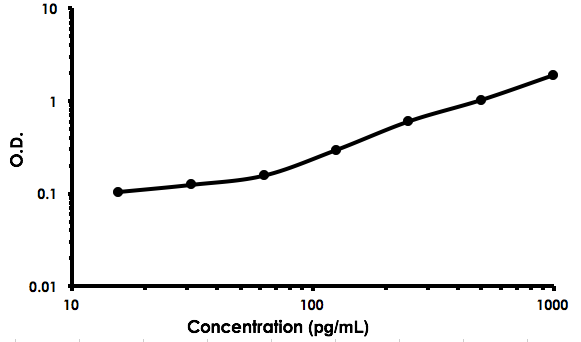Rat Rantes ELISA Kit (ab213907)
Key features and details
- Sensitivity: 1 pg/ml
- Range: 15.6 pg/ml - 1000 pg/ml
- Sample type: Cell culture supernatant, Cit plasma, EDTA Plasma, Hep Plasma, Serum
- Detection method: Colorimetric
- Assay type: Sandwich (quantitative)
- Reacts with: Rat
Overview
-
Product name
Rat Rantes ELISA Kit
See all RANTES kits -
Detection method
Colorimetric -
Precision
Intra-assay Sample n Mean SD CV% Sample 1 16 135pg/ml 6.21 4.6% Sample 2 16 327pg/ml 17 5.2% Sample 3 16 536pg/ml 29.48 5.5% Inter-assay Sample n Mean SD CV% Sample 1 24 118pg/ml 9.68 8.2% Sample 2 24 293pg/ml 19.63 6.7% Sample 3 24 625pg/ml 43.75 7% -
Sample type
Cell culture supernatant, Serum, Hep Plasma, EDTA Plasma, Cit plasma -
Assay type
Sandwich (quantitative) -
Sensitivity
< 1 pg/ml -
Range
15.6 pg/ml - 1000 pg/ml -
Assay time
3h 30m -
Assay duration
Multiple steps standard assay -
Species reactivity
Reacts with: Rat -
Product overview
The Rat Rantes Enzyme-Linked Immunosorbent Assay (ELISA) kit (ab213907) is designed for the quantitative measurement of Rat Rantes in cell culture supernatants, serum and plasma (heparin, EDTA, citrate).
The ELISA kit is based on standard sandwich enzyme-linked immune-sorbent assay technology. A monoclonal antibody from mouse specific for Rantes has been pre-coated onto 96-well plates. Standards and test samples are added to the wells; a biotinylated detection polyclonal antibody from goat specific for Rantes is added subsequently and then followed by washing with PBS or TBS buffer. Avidin-Biotin-Peroxidase Complex is added and unbound conjugates are washed away with PBS or TBS buffer. HRP substrate TMB is used to visualize HRP enzymatic reaction. TMB is catalyzed by HRP to produce a blue color product that changed into yellow after adding acidic stop solution. The density of yellow is proportional to the Rat Rantes amount of sample captured in plate.
-
Notes
Rantes (regulated on activation normal T cell expressed and secreted) is one of the natural ligands for the chemokine receptor CCR5 and potently suppresses in vitro replication of the R5 strains of HIV-1, which use CCR5 as a coreceptor. Peripheral blood mononuclear cells or CD4(+) lymphocytes obtained from different individuals have wide variations in their ability to secrete Rantes. The Rantes gene product is predicted to be 10 kDa and, after cleavage of the signal peptide, approximately 8 kDa. Of the 68 residues, 4 are cysteines, and there are no sites for N-linked glycosylation. Rantes is expressed by cultured T cell lines that are Ag specific and growth factor dependent.
-
Platform
Pre-coated microplate (12 x 8 well strips)
Properties
-
Storage instructions
Store at -20°C. Please refer to protocols. -
Components Identifier 1 x 96 tests 1 x 96 tests ABC Diluent Buffer Blue Cap 1 x 12ml 1 x 12ml Adhesive Plate Seal 4 units 4 units Antibody Diluent Buffer Green Cap 1 x 12ml 1 x 12ml Anti-rat Rantes coated Microplate (12 x 8 wells) 1 unit 1 unit Avidin-Biotin-Peroxidase Complex (ABC) 1 x 100µl 1 x 100µl Biotinylated anti- Rat Rantes antibody 1 x 100µl 1 x 100µl Lyophilized recombinant Rat Rantes standard 2 vials 2 vials Sample Diluent Buffer Green Cap 1 x 30ml 1 x 30ml TMB Color Developing Agent Black Cap 1 x 10ml 1 x 10ml TMB Stop Solution Yellow Cap 1 x 10ml 1 x 10ml Wash Buffer (25X) 1 x 20ml 1 x 20ml -
Research areas
-
Function
Chemoattractant for blood monocytes, memory T-helper cells and eosinophils. Causes the release of histamine from basophils and activates eosinophils. Binds to CCR1, CCR3, CCR4 and CCR5. One of the major HIV-suppressive factors produced by CD8+ T-cells. Recombinant RANTES protein induces a dose-dependent inhibition of different strains of HIV-1, HIV-2, and simian immunodeficiency virus (SIV). The processed form RANTES(3-68) acts as a natural chemotaxis inhibitor and is a more potent inhibitor of HIV-1-infection. The second processed form RANTES(4-68) exhibits reduced chemotactic and HIV-suppressive activity compared with RANTES(1-68) and RANTES(3-68) and is generated by an unidentified enzyme associated with monocytes and neutrophils. -
Tissue specificity
T-cell and macrophage specific. -
Sequence similarities
Belongs to the intercrine beta (chemokine CC) family. -
Post-translational
modificationsN-terminal processed form RANTES(3-68) is produced by proteolytic cleavage, probably by DPP4, after secretion from peripheral blood leukocytes and cultured sarcoma cells.
The identity of the O-linked saccharides at Ser-27 and Ser-28 are not reported in PubMed:1380064. They are assigned by similarity. -
Cellular localization
Secreted. - Information by UniProt
-
Alternative names
- Beta chemokine RANTES
- Beta chemokine RANTES precursor
- C C motif chemokine 5
see all -
Database links
- Entrez Gene: 81780 Rat
- SwissProt: P50231 Rat
Images
Datasheets and documents
-
SDS download
-
Datasheet download
References (0)
ab213907 has not yet been referenced specifically in any publications.
